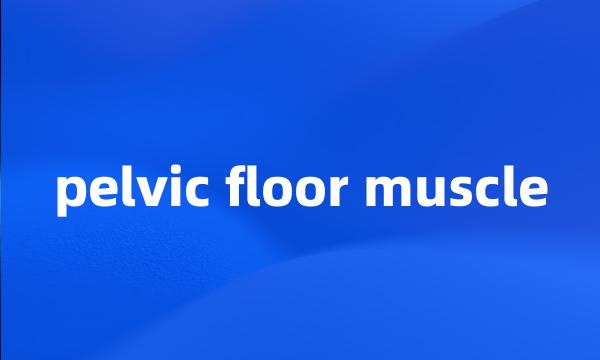pelvic floor muscle
- 网络盆底肌;盆底肌肉;骨盆底肌
 pelvic floor muscle
pelvic floor muscle-
Effect of Pelvic Floor Muscle Training on Prevention of Genital Tract Infection in Parturient Women
产妇盆底肌肉锻炼对生殖道感染的预防
-
Clinical observation of pelvic floor muscle exercise combined with estrogen in the treatment of stress urinary incontinence in post-menopausal women
盆底肌肉锻炼联合雌激素治疗绝经妇女压力性尿失禁的临床观察
-
Clinical effect observation for maternal pelvic floor muscle exercise by individual guidance
个体化指导产妇盆底肌锻炼的临床效果观察
-
The impact of maternal factors that pelvic floor muscle exercise and specific guidance
影响产妇盆底肌锻炼的因素及针对性指导
-
Effect of different delivery methods on the pelvic floor muscle strength in the early postpartum
不同分娩方式对产后早期盆底肌力影响的研究
-
The clinical application of pelvic floor muscle electrical stimulation in the female patients with urinary incontinence
盆底肌电刺激在女性尿失禁治疗中的应用
-
Study on Pelvic Floor Muscle Function Barrier of Post-natal Feminine and Its Rehabilitation Training
产后女性盆底肌功能障碍及康复锻炼的研究
-
Microwave combined with pelvic floor muscle exercise treatment for the middle and elderly patients with urinary incontinence
微波并盆底肌锻炼治疗中老年尿失禁
-
Objective To discuss clinical effect of pelvic floor muscle training in prevention and treatment of female urinary incontinence postpartum .
目的探讨盆底肌功能训练在防治女性产后尿失禁的临床应用效果。
-
Observation on effect of electric stimulation-biofeedback therapy on recovery of pelvic floor muscle of women with different delivery modes
电刺激联合生物反馈疗法对不同分娩方式产妇产后盆底肌康复疗效观察
-
Among them , the effect of microwave combined with pelvic floor muscle exercise group was the best ( P < 0.01 ) .
疗效以微波配合盆底肌锻炼组较显著(P<0.01)。
-
A prospective control study on treatment of stress urinary incontinence with α - adrenoceptor agonists and pelvic floor muscle exercises
盐酸米多君和盆底肌肉锻炼治疗压力性尿失禁的随机对照研究
-
Objective index : cough test , stop test , pelvic floor muscle strength , pelvic floor muscle endurance , coordination ability . 3 .
客观指标:咳嗽测试、终止测试、盆底肌力量、盆底肌耐力、协调能力。
-
Conclusion Postpartum pelvic floor muscle function training can be effective in preventing postpartum incontinence patients , the effect is significant , worthy of clinical use .
结论对产妇产后进行盆底肌功能训练可有效地防止患者出现产后尿失禁,效果显著,值得在临床推广使用。
-
Observation on therapeutic effect of dog-day acupuncture and moxibustion combined with pelvic floor muscle exercises for treatment of female stress urinary incontinence
三伏针灸联合盆底肌训练治疗女性压力性尿失禁疗效观察
-
However , presently , there was still numerous debate to the structure , the boundary and the embryonal source of pelvic floor muscle .
然而目前对于盆底肌结构、各肌肉分界及胚胎发育来源等问题仍存在争议。
-
The cognitive interventions can improve the clinical effects of the non-surgical treatment ( pelvic floor muscle training and medication ) in women with urinary incontinence .
认知干预能够显著增强患者采用非手术治疗(盆底肌肉锻炼和药物治疗的)的临床效果。非手术治疗联合认知干预是治疗女性尿失禁的有效治疗方式。
-
" Pelvic floor muscle training with or without biofeedback is useful and should be recommended to improve urinary incontinence after radical prostatectomy ," Dr.
无论是生物反馈性还是非生物反馈性骨盆底肌肉练习都有助于改善经根治性前列腺切除术后尿失禁,应予推荐。
-
The function of pelvic floor muscle is blocking the pelvic floor and sustaining the organs of cavitas pelvis to exercise their function respectively .
盆底肌,即盆底肌肉,是指封闭骨盆底的肌肉群。这一肌肉群维持盆腔器官正常位置以便行使其功能。
-
After delivery in three months , 6 months and12 months , respectively , the patients were evaluated maternal urination , pelvic floor muscle contraction and pad test positive results .
在产妇分娩后3个月、6个月及12个月时,分别评价两组产妇的排尿情况、盆底肌肉收缩能力和尿垫试验阳性结果。
-
Non-operation treatment , including alteration of life style , pelvic floor muscle training , behavioral therapy , biofeedback and drug treatment , mainly refer to lighter symptom or young women .
非手术治疗主要是包括改变生活方式、盆底肌锻炼、行为疗法、生物反馈电刺激治疗、药物治疗等,适用于症状较轻的患者及年轻女性,使用范围较窄。
-
Objective To explore the mechanism of the referred pains in pelvic pain due to chronic prostatitis and the relation between pain due to prostatitis and pelvic floor muscle dysfunction .
目的探讨慢性前列腺炎疼痛的神经机制以及疼痛产生与盆底肌功能障碍的关系。
